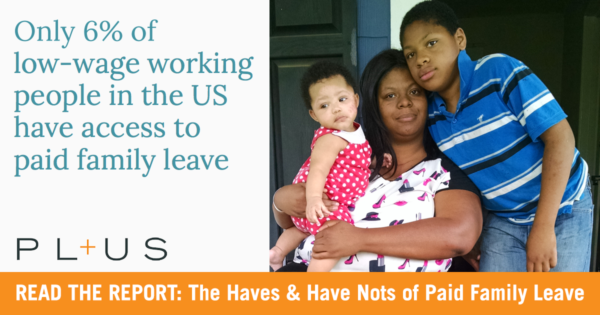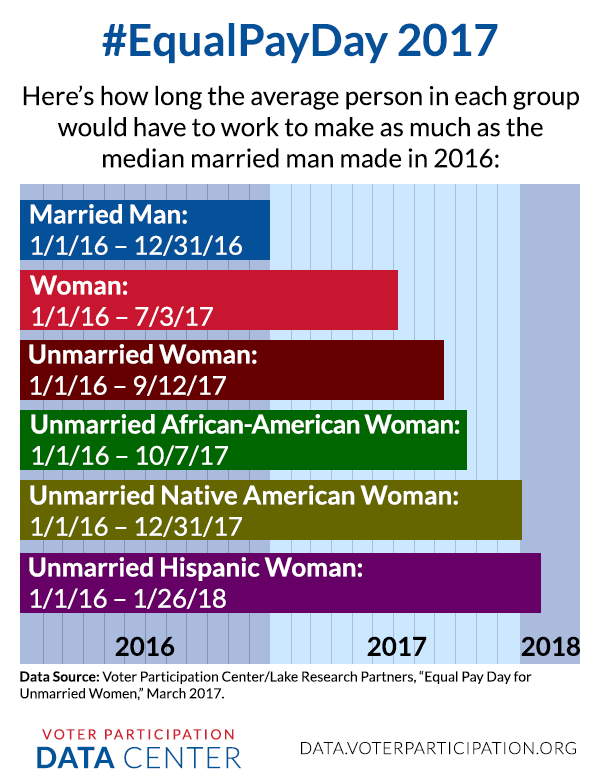2016 Census Data: September
The VPC research team has prepared this update based on the Census Bureau’s September 2017 data release, containing data for calendar year 2016. The final year of the Obama administration was generally filled with good economic news: median household income rose, the number of people in poverty fell, and the uninsured rate decreased. Read the full report below.
Downloads
The Haves and Have Notes of Paid Family Leave
Paid Leave for the United States (PL+US) has a new report that looks at the different paid parental leave offered to corporate vs frontline employees at some of the country’s largest companies – and the impact that inequity has on low-income families.
In the United States today, paid family leave is an elite benefit: 94% of low-income working people have no access to paid family leave. Millions of Americans don’t get even a single day of paid time for caregiving. 1 in 4 new moms in the U.S. is back at work just ten days after childbirth. While public discourse often focuses on income inequality, there is another critical way families experience inequality: the inability to be with their babies and families for the most important moments of their lives.
Read the PL+US report’s findings and their index of the top retailers leading the way — and the major corporate employers that are lagging behind.
Equal Pay Day for Unmarried Women: 2017
54 years after the Equal Pay Act was signed into law, women are still fighting to earn the same earnings as men for equal work. According to the most recent data on 2016 available from the U.S. Census Bureau, women on average make 80 cents for every dollar a man makes.
Earning disparities are even greater for unmarried women, who have seen a steady three-year decline on their earnings in comparison to married men. Unmarried women now earn only 59 cents to every dollar a married man earns, part of an ever-consistent pattern of unmarried women being left behind, even in a growing and improving economy.
In short, there have been no real substantive gains for women. In fact, equal wages is seeing a backwards trend while married men continue to see their earning power grow. Read about the particular difficulties facing unmarried women of color and single mothers and the real, day-to-day consequences of the pay gap.
Downloads
Equal Pay Day 2017: Unmarried Women and the #WageGap
April 4, 2017 is Equal Pay Day 2017 — the date that symbolizes how far into 2017 the average woman has to work in order to make the same amount as the average man. According to 2016 US Census data, the wage gap for 2016 was the same as in 2015: for every $1 the average man is paid, the average woman is paid only $0.80.
Unmarried women are hit particularly hard by the wage gap. For every $1 the average man earns, the average unmarried woman is paid only $0.71… and for every $1 the average married man is paid, the average unmarried woman is paid only $0.59. That means that the average unmarried woman has to work until May 31, 2017 just to make the same as the average man did in 2016, and until September 12, 2017 to make the same as the average married man did in 2016.
And it’s even worse for unmarried women of color: For every $1 the average married man is paid, the average unmarried African-American woman is paid only $0.57, the average unmarried Native American woman only $0.50, and the average unmarried Hispanic woman only $0.48. That means that in order to make as much as the average married man made in 2016, the average unmarried Hispanic woman will have to work until January 26, 2018.
Here’s a state-by-state breakdown of the wage gap for unmarried women. What is the wage gap for your state?
The Wage Gap for Unmarried Women (2016)

Pay Gap by State (2017)
For more details, read the full report from Lake Research Partners and the Voter Participation Center about Equal Pay Day for unmarried women.
Share this post widely on social media to raise awareness of the wage gap and the importance of #EqualPay.
CAP Report: The Pillars of Equity
A new report from the Center for American Progress, The Pillars of Equity: A Vision for Economic Security and Reproductive Justice, explores in detail the reasons that “reproductive health, rights, and justice must be integral to a successful, 21st-century economic agenda” and offers concrete policy recommendations designed to help women achieve economic security and reproductive justice in tandem.
This comprehensive policy approach “requires a policy agenda that promotes self-determination, access to comprehensive and affordable services, parenting supports, and a responsive workplace. This ensures that women—regardless of location, income status, race, sexual orientation, or age—have access to the services and resources they need in a timely, culturally competent, respectful, and affordable way that will help contribute to their economic mobility.”
“An investment in reproductive health means an investment in America’s promise of equality for all. That promise must be as adaptable and expansive as the roles women play in society. Policies and cultural norms must evolve so that women can participate freely in society and use all of their talents to strengthen families. Economic opportunities for women ensure that they can chart their own reproductive destiny and better achieve economic security. When all people are able to achieve their best economic opportunity, the entire national economy thrives and grows.”
IWPR: 5 Facts about Women and the Economy
For International Women’s Day and the “A Day Without a Woman” strikes occurring across America, the Institute for Women’s Policy Research has compiled together 5 important facts to know about women and the economy:
1. Hispanic women will wait 232 years for equal pay, if current trends continue.
2. Equal pay would cut poverty by more than half for working women and grow the U.S. economy.
3. Job Segregation keeps 1 in 4 working women in traditional care, serving, and cleaning roles with lowest pay.
4. Women account for only 1 in 3 workers in good, growing, middle-skill occupations.
5. A national paid leave policy could help young working mothers, a group least likely to have access to leave.
Read more from IWPR about these economic barriers women continue to face in our economy.
New Census Data Shows a Huge Gender Gap in Income
The U.S. Census Bureau’s latest report gives undeniable evidence of “a persisting large gender gap in incomes in the United States. The fact that nearly one fifth of all family households are headed by a single woman and that these households have incomes far below the national average, is cause for major concern.”
WIAReport continues, “for single women living alone, the median income in 2015 was $29,022. For single men living alone, the median income was $40,762. Thus, single women had a median income of 71.2 percent of the median income of single men.”
Indeed, the data shows that the median income for households headed by single women in 2015 was $37,797, and that these counted for 19% of all households in America.
EPI: "Women's work" and the gender pay gap
The Economic Policy Institute took an in-depth look at the pay gap, and the factors that cause it. Finding that “Women are paid 79 cents for every dollar paid to men—despite the fact that over the last several decades millions more women have joined the workforce and made huge gains in their educational attainment,” the authors conclude that:
“The gender wage gap is real—and hurts women across the board. Too often it is assumed that this gap is not evidence of discrimination, but is instead a statistical artifact of failing to adjust for factors that could drive earnings differences between men and women. However, these factors—particularly occupational differences between women and men—are themselves affected by gender bias. Serious attempts to understand the gender wage gap should not include shifting the blame to women for not earning more. Rather, these attempts should examine where our economy provides unequal opportunities for women at every point of their education, training, and career choices.”
New Survey Shows Strong Support for Paid Family Leave Fund
Paid family leave, paid sick leave, and affordable childcare: these aren’t political talking points, they’re the sort of public policies that will allow working families – including Unmarried Women and the Rising American Electorate – to succeed in today’s economy. A new poll commissioned by the Work Family Strategy Council shows that these policies enjoy overwhelming support with American voters: “By a nearly 2-1 margin, 61 percent of voters in these states, which include Iowa, support the creation of a national paid family and medical leave fund, 69 percent support a paid sick days law, and 57 percent support increasing access to high-quality, affordable child care, according to the survey. Among Iowans polled, 63 percent said they support a national paid family and medical leave fund, while 25 percent said they oppose it.”
Other critical takeaways from the poll include:
- “Overall, a majority of voters in the 15 states believe a national paid family and medical leave fund would make the country better off, while only 26 percent think it would make the country worse off.”
- “Voters across states say they favor a law that would create a national paid family and medical leave fund: 61 percent say they favor such a law, 44 percent say they strongly favor one, while 34 percent are opposed.”
- “A strong majority of people surveyed say they face challenges when managing job, family and personal responsibilities: 63 percent of full-time workers and 67 percent of part-time workers say they would be likely to face significant economic hardship if they had to take time from their jobs without pay to care for a new child, care for a seriously ill loved one or deal with their own serious health issue.”
Read the full article at Business Record.com
Wonkblog: How Sexism Holds Back the Economy
A new Organization for Economic Cooperation and Development (OECD) report “finds a correlation between states that mandate more family-friendly policy and higher rates of women working in those states.”
“Such policies, said Angel Gurria, the OECD’s secretary-general, in an interview, signal to women that “They can have babies and bosses at the same time, or be bosses themselves, rather than choose one.”
While the pay gap in America has fallen over the past few decades, Gurria warns that it is “still massive.” The report “suggests a basket of policy changes to encourage more women and African-Americans to work, and to help those groups obtain more skills and better jobs. They include “family-friendly” policies, such as mandated paid parental leave and expanded public access to day care and pre-school, that help women who might otherwise drop out of the labor force to raise their children and struggle to return to a similarly paid job in the future.”

Read the full story at Washington Post’s Wonkblog.



